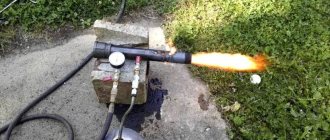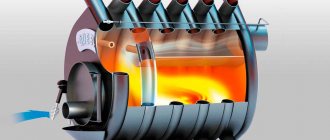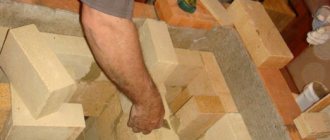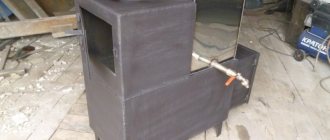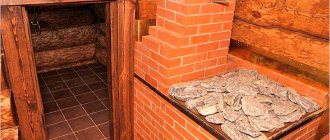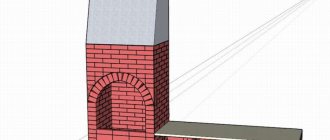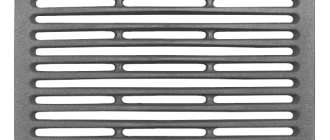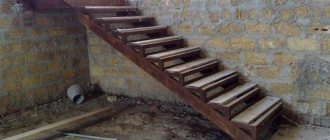Construction of a furnace always requires care and compliance with all technological requirements. This is especially true for the design of a bathhouse, since the stove is considered its most important part.
The main tasks of a homemade metal stove are to heat water and air. The stove heater can be:
- closed;
- open.
Of course, in a closed structure heat is retained much longer. However, to achieve the desired temperature in the steam room, more fuel and time will be required. For infrequent visits, professionals advise installing a closed heater in the bathhouse.
The steam room heats up much faster in an open type heater. However, if you splash water on the stones, it begins to cool quickly.
The steam room always contains solid stones with rounded sides.
What is the difference between a metal stove for a bath and a stove in a sauna?
The main difference can be called the vaping temperature. In a sauna it can reach 85 degrees, and sometimes much more. This temperature does not allow high humidity. A person may get severely burned.
Therefore, the humidity in the sauna is always maintained at no more than 5–15%.
In an ordinary Russian steam room, the temperature is in the range of 55–65 degrees. Very rarely it can reach 70 degrees. For this temperature, the humidity value is specially raised. It is in the range of 50–60%.
To solve such problems, you need an appropriate approach to the construction of the furnace. For installation in a sauna, it is necessary that the stove body be in contact with the surrounding atmosphere as much as possible. Air flows must move at high speed along the walls.
The main task is to quickly heat the steam room to the desired temperature. The sauna itself usually has a small open-type heater mounted above the firebox.
Heating of stones in such a furnace reaches only 200–250 degrees. The surrounding air picks up a lot of heat. This type of heater can only create a small amount of steam. This is quite enough for a sauna. One ladle of water will give 15% humidity. A person will not be able to tolerate its greater significance.
The task of an ordinary Russian steam room is completely different. The main thing is that there is a lot of steam. It is very important to achieve its certain state. It should look like small drops. This type of steam is called “dry”. It has a high temperature, approximately 130–150 degrees. A person, finding himself in such conditions, feels a powerful surge of strength. To get such steam you need to heat the stones above 500 degrees. To do this, they are lowered deep inside the firebox, with a closed heater installed. All the differences described above must be taken into account when building a furnace.
What types of wood-burning stoves for baths are there: comparison
Wood heating appliances do an excellent job of heating large and small rooms. You can make such a stove from refractory bricks or thick-walled metal sheets and cast iron. Brick kilns are capital structures with heavy weight that require a solid foundation. Metal models are more compact and do not take up much space. Let's compare these two types.
| Brick oven | Metal oven |
| pros | |
| Retains heat for a long time thanks to the large number of heated stones. | It will cost less than brick. |
| Creates a gentle heat that does not burn the skin and mucous membranes, and deeply warms the body. | Can be mounted in any corner of the steam room and does not require much space. |
| When using high-quality bricks, it will last for more than one generation of house residents. | Heats up the steam room quickly – in a couple of hours. |
| Simple and safe to use. | Saves fuel. |
| Minuses | |
| Long kindling – up to 5 hours. | Cools down quickly without adding fuel. |
| Takes up quite a lot of space in the steam room. | The cabinet becomes very hot and may cause burns or thermal shock. |
| In terms of the cost of the material and the cost of laying it from a professional craftsman, it is more expensive than its metal counterpart. | It may burst due to a sudden change in temperature (do not splash cold water). |
| Needs a reinforced foundation. | Over time it burns out and requires replacement. |
Owners of home baths are increasingly choosing a combined version of the stove: the inside is welded from metal, the outside is lined with refractory bricks. This tandem allows you to use all the strengths of stone and metal without the risk of burns and with significant fuel savings.
Homemade stoves made of metal and brick are not as expensive as purely brick ones and are quite easy to install
Dimensions of the heater
If the insulation of the bath was done in accordance with the technological process, then the volume of the steam room will affect the number of stones. There are several sources that recommend using a certain number of stones. On average per 1 cubic. meter there are 20–40 stones. In fact, the more stones you use, the faster you can get the desired volume of steam. However, one condition must be met. The oven power must be sufficient to heat them.
The main problem that has to be solved is the density of the stones. Each breed has its own. Therefore, the same mass may differ in different volumes. An average steam room, with a volume of 12–14 cubic meters, is well heated by a heater with dimensions of 30x40x30 millimeters. Depending on the design of the furnace, these values may vary.
To make such a thermal calculation, you need special knowledge and experience. It is much easier to use ready-made drawings in which certain proportions have already been calculated. In principle, at a minimum, the volume of the firebox in which the heater is not installed should not be less. Ideally, it should be even 30-50% more.
Make it yourself or order it
Before choosing whether to buy a budget factory model, hire the services of a craftsman, or make a stove yourself, you need to soberly assess your skills as a home craftsman and the strength of your desire.
If you know how to cook at least a little and have worked a little with metal, you have a welding unit or you can rent it, you can safely take on the work yourself. The services of a master with his equipment will cost a tidy sum.
Therefore, it is worth weighing all the pros and cons before getting down to work.
Where should the stone container be installed?
It has long been known that the temperature reaches its maximum in the upper region, near the back wall. This is where it is best to install such a container. The furnace roof will experience less thermal stress, and the stones will heat up well. The heater requires constant maintenance. Water must penetrate inside. The hatch intended for servicing must be located in a place where the furthest edge can be reached.
Water must be supplied deep into the heater without causing a burn. One or more tubes are inserted into the heater, which completely cover the entire container. A funnel is inserted into each tube lined with stones. When water is supplied to the tube, it begins to quickly cover the surface of the stones, and its rapid evaporation occurs.
How to improve the efficiency of an iron stove
Effective methods include:
- Furnace lining. The point is to line the inside of the firebox with fireclay bricks. It is enough to place it on the edge, then the lining will be up to 6 cm thick, when using narrow fireclay for masonry - 3 cm. It will be the heater that warms up, not the steel walls of the stove. It is recommended to plan the lining at the drawing development stage in order to increase the size of the firebox for lining in advance. The disadvantage of this method is the production of hot smoke. The solution is to install the heater on the pipe.
- Creating a brick screen around the stove. Material – ceramic brick. An opening is left in the brickwork for the doors so that the air heating can be regulated. The downside is overheating of the rear wall. The solution is to use thickened heat-resistant steel for the firebox.
When making a stove at home, it is important to pay attention to the seams. The service life of the product depends on their quality. Inaccurate application often causes the product to quickly burn out. Their number should be minimal in the upper part of the oven.
We recommend reading: “How to properly heat a stove with wood.”
Firebox
The firebox is made first. Dimensions are determined individually. Experienced craftsmen recommend that if the width reaches 50 cm, create a similar height. A homemade sauna stove should include the use of ready-made metal parts such as grates and doors.
It must be said that it is better to use steel parts, since cast iron products are distinguished by their fixation.
In a standard design of a metal furnace, a firebox has two sections. The first is intended for burning fuel. The second will collect ash. Therefore, they are separated by a grille and separate doors are installed.
Very often, the window of the section in which the ash is collected is used to increase the draft required to create normal combustion.
If the design of a metal sauna stove shows the installation of a heater, the upper section of the firebox should also be made of a grate.
Important! To build a stove, it is better to take thick sheet metal. The structure will be stable and will not be damaged by strong heat. It will generate a lot more heat.
Flaws
In addition to the advantages, homemade designs also have several disadvantages. It is noteworthy that they are characteristic of almost all possible varieties.
The first disadvantage is the short cooling time of the structure. This does not allow maintaining the optimal temperature for a long time without the use of additional fuel.
Also, a homemade stove is not able to heat a large room, so its range of applications is somewhat smaller than that of professional models capable of heating large rooms.
To reduce the risk of fire and increase the safety of the structure, it is necessary to additionally equip the walls on 3 sides and the body with fire-resistant material, which ultimately results in additional costs for the purchase of the necessary materials.
Most structures have a relatively unaesthetic appearance; all welds are clearly visible, which makes the stove stand out from the general background in the room, making it look sloppy.
Homemade metal sauna stove project
This design was developed for a steam room, with dimensions of 2x3x2.3 m. 3 mm sheet metal was used for welding.
To improve combustion, the connection of another air duct coming from the outside was specially designed. Another technological solution was stiffening ribs. These corners are welded on the sides, to the upper section of the firebox. When strong heating occurs, the metal will not begin to bend.
Another diagram shows a metal furnace where air is supplied to the upper section of the firebox. These structures are called “afterburners”.
A metal plate is welded to the back wall. A gap forms between the welded plate and the wall. Tubes are inserted into it, through which air is supplied under the grate.
This simple device helps solve two problems. First of all, the rear wall is intensively cooled and protected from burning.
The second positive point is the supply of already heated air. This area contains very hot flue gases. Approximately 80% of them are considered flammable. When these gases combine with hot air, flammable substances ignite.
The temperature of the upper section of the firebox increases significantly. The stones are heated to a very high temperature. Moreover, if you use dry firewood for this, you will need much less of it.
Most long-burning stoves operate on this principle. This method began to be used for sauna stoves several years ago.
Exactly the same model, without afterburning, has a slightly different format. There are no dimensions in the drawing, but it is much easier to understand what proportions are needed and how the various parts are located.
Choosing the right metal
Cast iron walls are best suited for a heat-resistant stove, since the metal tolerates high temperatures well and is able to retain heat for a long time. But due to the inflated price, it is often replaced with thicker steel.
It is recommended to take sheet steel with a thickness of at least 10 mm under the bottom of the internal heater. A bottom with a smaller thickness will not withstand high heat for long and will quickly burn out. The consequence will be smoke in the steam room.
The furnace walls must be made of steel with a thickness of 5 mm. With lower values, the service life of the equipment will not exceed 5 years. In factory products, the wall thickness is from 10 mm.
When purchasing finished equipment, it is important to pay attention to the chromium content in the metal. The indicator should be at the level of 12-13%. Such a stove will last longer and retain heat better.
Users often search for:
- Bathhouse decoration
- Covering the bathhouse with clapboard
Metal stove equipped with a water tank
This design works great. The “spark arrestor” increases the path of movement of flue gases. They stay in the firebox much longer, and the heating of the walls improves. Instead of a tank, you can put stones.
The option looks quite interesting when the tank is installed in the rear area of the stove.
The chimney moves back. It goes straight through the tank. Since the height of the tank is quite large, the efficiency of heat removal increases. The design of the heater is also of interest. Its dimensions are not significant, but for a small steam room this is quite enough.
The process of closing the lid is inconvenient. It can only be done from a certain side. It is very difficult to close the lid when water has been supplied to the heater. A plus is ease of maintenance.
Preparation of materials and tools
Before making a stove for a sauna from a pipe, you need to study the video instructions and drawings, and also prepare a workplace. This could be a covered outdoor shed, a home workshop, or a garage.
For work you will need:
- A metal pipe with thick walls 1.2–1.5 meters long and with a diameter of 500 to 650 mm. In the design, it will serve as a firebox and a water tank.
- Metal pipe for a chimney with a wall thickness of 2–4 mm and a diameter of 120–150 mm.
- Steel pipe for heater equipment with a diameter of 350 mm. The thickness of its walls should be from 5 to 8 mm.
- Metal garage hinges.
- Several sheets of metal with a wall thickness of 2–4 mm and sizes from 600 to 800 mm.
- Ready-made cast iron grates or 500 mm of metal fittings with diameters of 12–18 mm.
- A threaded water pipe 50–80 cm long and ½ inch in diameter. The same diameter water tap with internal thread.
- Manual or semi-automatic welding machine.
- Set of locksmith tools.
- Electric drill.
- Grinder with cleaning and cutting discs.
How to choose a pipe?
Above we have already encountered digital designations for pipe sizes. Now let's take a closer look at what they mean and how to effectively use this information for further purposes.
Interesting: Review of the best types of sauna stoves: how to choose, pros and cons, which one to buy, rating In the specifications, round steel
pipes are always classified by internal diameter; The 2nd number indicates the wall thickness, and the following symbols, if any, indicate the type and special characteristics. For profile pipes, the first 2 digits are the maximum cross-sectional dimensions, then the 3rd is the wall thickness.
The default units are millimeters; others are indicated explicitly. For example, “body - pipe 530x10” means that it is made of a pipe with an internal diameter of 530 mm and a wall thickness of 10 mm, i.e. the outer diameter of the workpiece will be 550 mm plus or minus 5.3 mm, because The tolerance for the diameter of a regular pipe is 10% of the internal diameter. The tolerance is mainly spent on the ellipticity of the pipe. Further, the wall thickness can be different. Water pipes are produced in lightweight, regular and reinforced types. But, for example, the most common pipe 530 is produced with walls thickness from 6 to 12 mm in increments of 1 mm; the most common denominations are 6, 8 and 10 mm.
Why know all this? To choose the right blanks for the oven. The optimal diameter of a household stove is about half a meter, this allows you to get both good heating technology and sufficient ease of use. And for pipes from 500 mm, the nominal pitch of standard sizes is 10 mm, i.e. there are pipes 500, 510, 520 and 530; large ones are considered to be large-diameter pipes. That is, by selecting workpieces of different diameters and with different wall thicknesses, you can create a concentric structure, the parts of which will telescopically fit into each other with a minimum gap. And typing in the search, say, “buy steel water pipe 510x8 cuttings” is easier than bending a shell from an 8 mm sheet, isn’t it?
GOST 10704–91 (straight-seam steel pipes) and GOST 20295 85 (steel pipes with a spiral seam) specify the pipe diameter from 1 mm; The steps of the dimensional grid for different ranges of standard sizes are of a recommendatory nature. Pipe is one of the most popular products in general, and it would be simply stupid to regulate them scrupulously. In the range of 250-400 mm, the range of pipe sizes produced is very extensive. Let’s see below how this circumstance is used in amateur pipe and furnace projects.
Note: for a homemade stove, whenever possible, you should choose scraps of spiral pipes. They are more precise, less elliptical than straight-seam ones, made of higher quality steel, and still sold at the price of scrap metal. Solid drawn (seamless) pipes are even better, but are only suitable for small parts, maximum diameter is 250 mm.
Base
It is better to lay the foundation for the stove at the stage of building a bathhouse , and not when you already have the finished floor ready. Therefore, those who have completely decided on the type of future stove start with this:
First you need to dig a hole under the concrete foundation . Its dimensions vary for the horizontal and vertical position of the base pipe. For example, if you have a vertical stove made of a pipe with a diameter of 50-53 cm, then the concrete podium is made 70x70 cm.
So, the hole. You estimated the length and width from the above, and the depth should be about half a meter . But don’t be alarmed, the first 30 cm will go under the sand and gravel cushion, which is needed for greater stability of the base.
Before pouring the base,
a screed of liquid concrete (thin layer) is made.
The ratio of cement and sand is 1 to 4, water - as much as needed. This layer must dry before continuing work. a layer of waterproofing is laid on it , for example, sheets of roofing material, and the base itself will be poured on top of the waterproofing. Formwork is made for it. You can add fine gravel to the concrete , then the ratio will be as follows: 1 part cement to 2.5 parts sand and 4 parts gravel, water as needed.
The surface is leveled using a level - this is important! After hardening, a brick is laid on it, for example, fireclay, but red is also suitable. You can lay one, or two rows of bricks. The binder should be exclusively clay mortar .
When the base is finished, proceed to creating a protective screen . Its dimensions also depend on the size and position of the oven. But, since the stove is always either next to the wall or even in a corner, the flammable walls should be protected with a fireproof screen, and it is preferable to completely replace a piece of the wall with a fireproof one, especially if the stove has an external firebox.
We make a stove for the sauna
The main task of such heating devices is the speed of obtaining the required temperature, as well as the ability to constantly maintain it. The simplest solution is to install a fan. Due to the blowing of the walls, the temperature will increase.
The convector casing has a similar function. In other words, it is a body wrapped in a shell. A gap of approximately 1.5–2 cm appears between the firebox and the casing. Air is sucked into the gap from below.
It moves along the walls and begins to heat up, simultaneously cooling the walls. Then he starts to rise. Soft warmth begins to spread throughout the entire area of the steam room. If thick metal was used for the furnace body, it is allowed to make the casing from a thinner sheet. It will not heat up very much, so burning of the walls is excluded. If the heater will be located at the top, directly above the firebox (see photo), a hole is made in the body so that the heater can be ventilated. Part of the air flow rising along the walls will begin to flow directly into the heater. The laid stones will receive additional airflow and heat up even more. This heater is called “ventilated”. It is very good to use in dry air saunas.
Features of stove installation according to fire safety rules
In order for an iron sauna stove to work properly for many years, you must follow the basic installation rules:
- Heating equipment is installed on a pre-prepared platform with a diameter of 70 cm and a height of 18 cm. Additionally, a 30-centimeter foundation base made of heat-resistant bricks is installed. The distance from the stove body to the wall should be 100 cm. It is recommended to insulate the walls with heat-reflecting foil to prevent the surfaces from catching fire.
- The minimum distance from the top of the device body to the ceiling surface is 120 cm, and from the firebox door to the opposite wall - 135 cm.
- The chimney pipe is also insulated. For this purpose, installation of an internal and external protective casing with a layer of heat-insulating material is provided.
- When the chimney pipe is routed through the roof, at the junction with the ceiling, a protective galvanized steel box filled with basalt insulation is installed.
- The doors to the combustion chamber should be directed towards the entrance door, and the heaters should be directed towards the near corner.
- The shelves in the steam room are fixed along the wall opposite the one where the heating equipment is installed. The best option is a multi-tiered design.
- Lamps in the steam room are mounted above the front door or along the perimeter of the room, with the exception of the wall behind the stove. To avoid possible short circuits, it is not recommended to install lighting equipment on the ceiling.
- If a metal sauna stove is used in a wooden building, the body will need to be lined with heat-resistant brick. The optimal height of the structure is 125 cm, and the length is 85 cm.
- A test run of the equipment is carried out before the start of operation of the steam room to identify possible design defects or errors in its installation.

